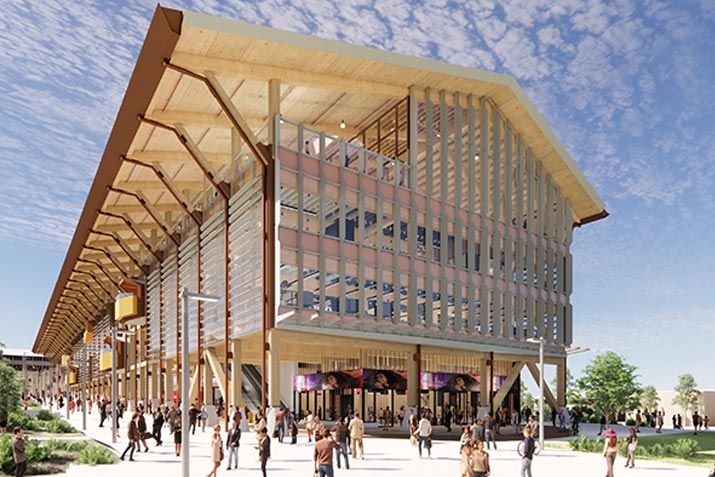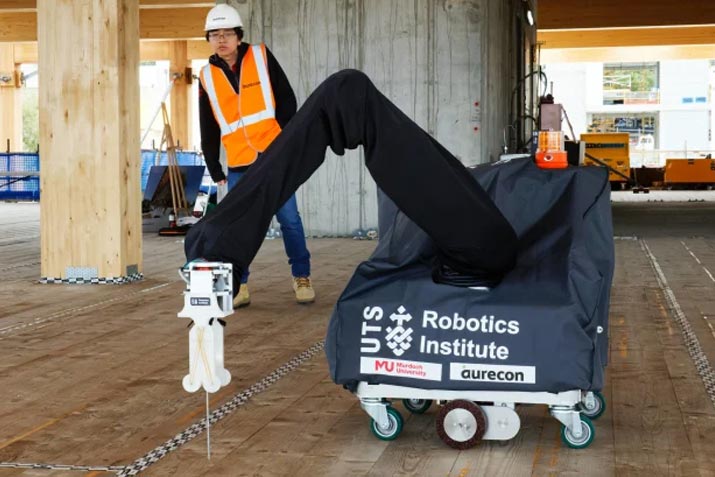

Western Australian building site use of innovative robot construction technology realises vision of the future.
A tanned tradie crouched on a wooden cross-beam, nail gun in hand, is the iconic image of building in Australia. The sun is shining, the blue cattle dog is sleeping in the shade of the ute and the house will be finished in a few months, if there are not too many delays (Robot construction).
That iconic image may be consigned to the story books if the trial overseen by Murdoch University, in conjunction with major partners Aurecon and the University of Technology Sydney (UTS) proves successful.
The robot construction technology was designed by UTS researchers to deliver screw fixings. And, this task is known to cause repetitive strain injuries given the labour-intensive nature of this work. This is particularly apparent on mass engineered timber (MET) construction projects.

ABOVE: UTS research engineer watches as the robot installs a screw fixing.
The catalyst for the trial is the construction of Building 360 at Murdoch’s South Street campus – a technology-rich, MET building which will accommodate up to 60 per cent of the university’s teaching requirements. Building 360 will be the largest MET building in Western Australia and a demonstration of Murdoch’s commitment to sustainability, aiming for a 6 Star Green Star rating once complete.
Murdoch University’s Vice Chancellor Professor Andrew Deeks said Building 360 would transform the student and staff experience through offering new, digitally enabled teaching and learning spaces in an environmentally friendly design.
“MET is a completely renewable resource and a more sustainable construction material than conventional steel or concrete, which is a huge contributor of greenhouse gas emissions globally. The building will also have a large array of photovoltaic cells to supply its power needs,” Professor Deeks said.
“Working with our design, engineering and advisory partner Aurecon, we set out to determine where technology would add value to the construction process – an opportunity to modernise an industry that, by and large, is yet to take a significant leap in innovation.
“The concept was developed to trial robots installing screw fixings – an important, but labour-intensive task, that’s essential on MET construction sites.”
Watch their story here
Aurecon’s Managing Director, Built Environment Australia, Tim Spies, said the pilot project showed that by thinking more innovatively, the timber industry could lead the way in improving construction project outcomes.
“The project’s immediate objective is focused on a proof of concept, to demonstrate the robot’s capability of installing screw fixings in an accurate manner,” Mr Spies said.
“The long-term objective is to prove that the modular nature of timber construction will benefit from the automation of some on-site construction activities, helping to increase productivity, reduce cost, improve workers’ OH&S, and advance innovation in the construction industry.”
There are around 200,000 to 300,000 screw fixings on the Building 360 construction site and the robots was trialled installing approximately 50 to 100 fixings as part of the proof of concept.
The custom-designed robot comprises two components: a base housing the battery, sensors and navigation system, and the arm that installs screw fixings.
The robot’s built-in sensors and navigation systems survey its surroundings, correlate it with the building information modelling (BIM) data that has been preloaded, allow it to autonomously manoeuvre around the site and avoid obstacles, and make its way to the “target area” where it drills in the screw fixings using its robot arm.
CLICK HERE to return to the home page for more articles.